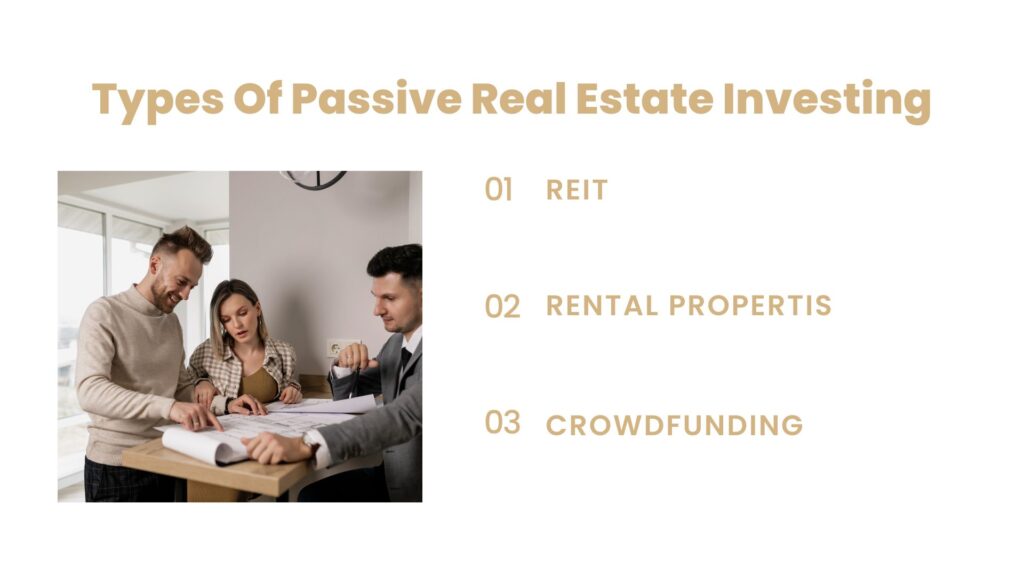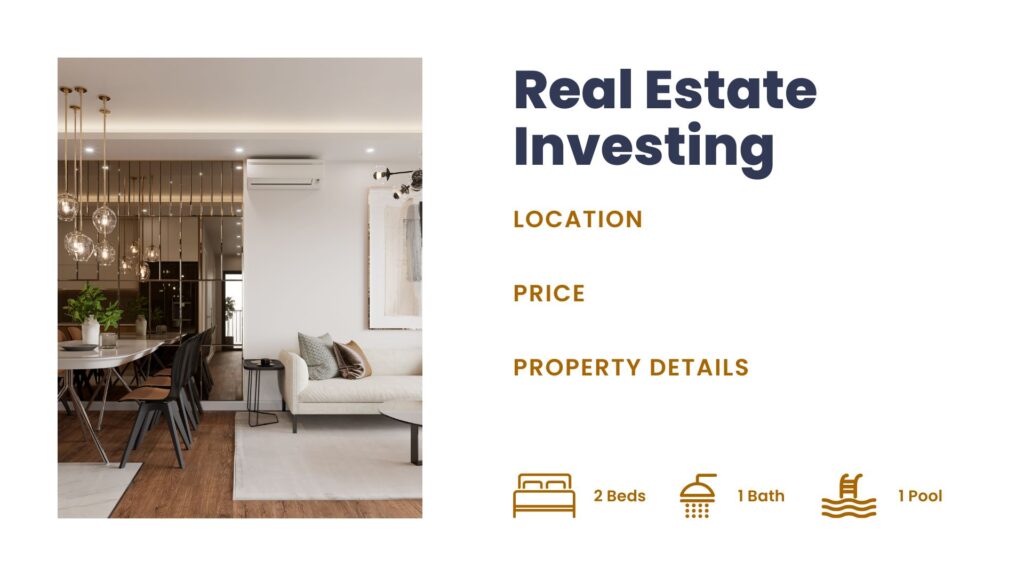What is Passive Real Estate Investing?
With passive real estate investing, you can generate rental cash flow and capitalize on property value growth—all without handling the typical duties of property ownership. Instead of managing tenants, repairs, or vacancies yourself, you invest through hands-off vehicles like REITs (real estate investment trusts), crowdfunding platforms (e.g., Fundraise), or rental property funds (e.g., Arrived Homes). These options pool investor capital to purchase and manage real estate, distributing profits as dividends or appreciation gains.
Passive vs. Active Real Estate Investing
| Aspect | Passive Investing | Active Investing |
|---|---|---|
| Time Commitment | Minimal (No direct management) | High (Tenant issues, maintenance, etc.) |
| Capital Required | Low (Start with 10–10–500) | High (Down payments, renovation costs) |
| Liquidity | Varies (REITs = High; Crowdfunding = Low) | Low (Selling property takes time) |
| Control | Limited (Fund managers make decisions) | Full (You choose properties & strategy) |
| Best For | Beginners, busy professionals, retirees | Hands-on investors seeking higher returns |
Why choose passive real estate investing (2025)?
- No Landlord Hassles: Avoid midnight tenant calls or repair emergencies.
- Diversification: Invest in multiple properties/regions with small amounts.
- Scalability: Easily grow your portfolio without buying whole properties.
- Passive Income: Earn dividends or rental payouts automatically.
For beginners, passive real estate investing offers a low-stress entry into real estate wealth-building. Active investing may yield higher returns, but requires expertise, time, and risk tolerance. It lets you earn rental income, benefit from property appreciation, and diversify your portfolio without the headaches of being a landlord. With options like REITs and crowdfunding platforms, you can start with as little as $100 and still tap into high-value commercial or residential properties. Unlike stocks, real estate offers tangible assets and historically stable returns, making it a smart hedge against inflation. Plus, automation tools and AI-driven platforms now simplify investing further, so you can build wealth while you sleep.
Key reasons to start in 2025
- Low Barrier to Entry: No need for massive capital or property management skills.
- Hands-Off Income: Earn dividends/rental income with zero active work.
- Diversification: Spread risk across properties/regions (eg., via REITs).
- Inflation Hedge: Real estate values and rents rise with inflation.
- Tech-Driven Tools: Platforms like Fundraise make investing effortless.
5 Ways to Invest Passively (2025)
REITs (Real Estate Investment Trusts)– Including Malaysian Options
Best for: Hands off-investors wanting liquidity & dividends.
REITs offer the easiest entry into passive real estate. These publicly traded companies own income-generating properties—from shopping malls to hospitals—and distribute 90% of profits as dividends making them attractive for passive income seekers. For Malaysian investors, local REITs like KLCC Property REIT (featuring prime Petronas Towers assets) and Sunway REIT (diversified across healthcare and retail) provide stable dividends in MYR, avoiding currency risk. Globally, REITs like Simon Property Group (USA) or Link REIT (Hong Kong) add international exposure. With share prices starting under RM50, REITs are ideal for beginners seeking liquidity and monthly income.
| Type | Example | Min. Investment | Target Returns | Liquidity |
|---|---|---|---|---|
| MY REITs | KLCC Property REIT | ~RM50/share | 5–7% p.a. | High |
| Global | Simon Property (USA) | $100+ | 4–10% p.a. | High |
Risk: Low-Medium (Publicly traded, but sensitive to interest rates.
Type of REITs
There are three main REIT categories:
- Equity REITs (own and operate income-generating properties)
- Mortgage REITs (invest in property mortgages)
- Hybrid REITs (combine both approaches)
REIT Performance considerations
While REITs provide regular income, their share prices can fluctuate with interest rates and economic conditions. Many investors hold REITs in tax-advantaged accounts since dividends are typically taxed as ordinary income. In Malaysia, investors can access both local REITs (like KLCC Property) and international options through brokerage accounts.
Fundraise (Global Crowdfunding)
Best for: Beginners seeking diversified US exposure.
Fundraise democratizes real estate investing by pooling funds from retail investors to buy US residential/commercial properties. With just $10, you can own slices of apartment complexes or industrial warehouses through their eREITs. Fundrise boasts 8–12% annual returns and quarterly dividends, though your money is locked for 5+ years. Their tech-driven platform is beginner-friendly, but note: returns are in USD, exposing Malaysians to forex fluctuations. A solid pick for hands-off investors wanting diversification beyond REITs.
| Platform | Minimum | Focus | Lock-Up Period | Target Returns |
|---|---|---|---|---|
| Fundrise | $10 | Residential/Commercial | 5+ years | 8–12% p.a. |
Risk: Medium (Private Market, USD forex risk)
Arrived Homes (Rental-Focused)
Best for: Investors who love tangible assets.
Arrived Homes lets you invest in single-family rental properties across the USA for $100 per share. They handle everything—purchasing, leasing, and maintenance—while you earn passive rental income (paid quarterly) and potential appreciation when homes sell (typically 5–7 year holds). Their curated portfolio targets 6–8% annual returns, making it perfect for those who want tangible assets without landlord hassles. However, like Fundraise, it’s USD-denominated and illiquid.
| Platform | Minimum | Asset Type | Payouts | Target Returns |
|---|---|---|---|---|
| Arrived Homes | $100 | Single-Family Homes | Quarterly | 6–8% p.a. |
Risk: Medium (Liquid, but properties are insured)
CrowdStreet (High-Net-Worth)
Best for: Accredited investors chasing premium yields.
High-net-worth individuals (HNIs) can access high-yield commercial real estate (office towers, hotels) via CrowdStreet. Minimums start at $25,000 per property, with projected 15–20% annual returns. Investments are vetted but carry higher risk—ideal for those comfortable with 5–10 year lockups and due diligence. While open globally, Malaysians should consult tax advisors, as profits may face double taxation. Best suited for sophisticated investors chasing premium yields.
| Platform | Minimum | Focus | Hold Period | Target IRR |
|---|---|---|---|---|
| CrowdStreet | $25,000 | Commercial (USA) | 5–10 years | 15–20% |
Risk: High (No Liquidity, project-specific risks)
[Bonus] RealtyMogul (Fundraise Alternative)
Similar to Fundrise but with more flexibility, RealtyMogul offers two options:
- Private REITs ($1,000 minimum, 8–10% returns)
- Individual properties ($5,000 minimum, 12%+ target)
Their industrial/retail focus complements Fundrise’s residential slant. A good backup if you prefer multiple platform diversification.
Comparison between RealtyMogul and Fundraise
| Factor | RealtyMogul | Fundrise |
|---|---|---|
| Minimum | $1,000 (REITs) | $10 |
| Focus | Industrial/Retail | Residential |
| Liquidity | 5+ years | 5+ years |
| Returns | 8–12% p.a. | 8–12% p.a. |

Malaysian Alternatives
For readers preferring local, MYR-denominated options:
- PropSocial (Crowdfunding for MY properties) – Min. RM1,000
- Brickz.my (fractional property ownership) – Min. RM500
- Islamic REITs (e.g., Al-Aqar Healthcare REIT) – Halal-compliant
Risk Comparison Cheat Sheet
| Platform | Risk Level | Why? |
|---|---|---|
| MY REITs | ★★☆☆☆ | Stable but rate-sensitive |
| Fundrise | ★★★☆☆ | USD risk, mid-term lockup |
| Arrived Homes | ★★☆☆☆ | Illiquid but asset-backed |
| CrowdStreet | ★★★★☆ | Project failures possible |
| PropSocial | ★★☆☆☆ | Local market risk only |
Final Recommendations
- Newbies: Start with Malaysian REITs + Fundrise
- Balanced: Add Arrived Homes for rental diversity
- Aggressive: Allocate <10% to CrowdStreet
Rental Properties
Rental properties are another form of passive real estate investing. In this type of investment, an individual or a company buys a property and rents it out to tenants. Rental property value can appreciate over time, providing the potential for capital gains.
But, owning rental properties also comes with responsibilities and risks, such as:
- the need to find and screen tenants
- manage and maintain the property
- deal with potential legal issues
They are subject to market fluctuations and local economic conditions.
Rental properties can be a great way to earn passive income and build wealth over time. But it’s important to consider the risks and responsibilities before investing.
Crowdfunding
Crowdfunding help to spread the risk across different investments. Its platforms are subject to regulatory oversight and compliance. Be aware of the following before investing:
- rules and regulations
- potential risks
Real estate syndications
It’s a group of investors who pools their money to buy and manage property or a portfolio of properties. In real estate syndication, an experienced sponsor or operator is the syndicator. His duty includes:
- raise capital from a group of investors, known as limited partners
- operate property or a portfolio of properties.
Syndicators act as the general partner and manage the properties. The partners provide the capital and share in the profits or losses of the investment.
Real estate syndications can invest in larger and more complex real estate deals. They provide access to professional management and expertise and mitigate the risks. But the risk level is higher than REITs.
Turnkey properties
The term “turnkey” refers to renovated properties and ready to be “turned” over to the new owner. It can begin generating rental income immediately. Advantages of investing in turnkey properties include:
- Immediate cash flow
- Professional management
- Reduced risk
with the cost of renovation and management, turnkey properties can be more expensive. Investors should be aware of the property management fee.
How to choose the right passive real estate investment?
Assessing risk vs. return
Risk and return are key factors to consider when evaluating any investment opportunity.
Risk refers to the potential for loss on an investment, while return refers to the potential for gain. REITs generally have a lower level of risk but also a lower level of return than a rental property. When assessing risk vs. return, it’s important to consider the following:
The potential return on investment (ROI)
This is the expected gain or loss on the investment. the potential return on the amount of risk is an important consideration.
The investor’s risk tolerance
Each investor has a different level of risk tolerance. It’s important to understand your risk tolerance and to invest in a way that is comfortable for you.
Once you’ve assessed the risk vs. return, it’s important to also consider other factors such as:
- property’s location
- property management
- condition of the property
- economy and market conditions
- Tax benefits
- investment liquidity
Researching property and market trends
When researching property and market trends, it’s important to consider the following:
- Location
- Property condition
- Economic and market conditions
There are several ways to research property and market trends which include:
- Online research
- visiting the property in person
- consulting with a real estate agent or a property management company
- tools such as the Case-Shiller home price index, Zillow’s home value index
- real estate market reports
Due diligence on property management or REIT management teams
This is an important step in choosing the right passive real estate investment. When conducting due diligence, it’s important to consider the following:
Experience
The management team’s experience and track record in the industry.
Reputation
The management team’s reputation within the industry
Communication and transparency
Investors should consider the level of communication and transparency by the management team.

Tips for successful passive real estate investing
Diversifying your portfolio
Diversification is an important strategy in any type of investing. It is the process of spreading your investments across different asset classes. In this way, you can spread out risk and reduce the volatility of your portfolio. Several ways you can diversify your passive real estate portfolio include:
- Investing in different types of properties
- Investing in different geographical areas
- Investing in different types of passive real estate investment
Staying informed about market trends and changes
You can learn about market trends and changes in the real estate market through:
Research online
Identify market data, analysis, and reports on real estate trends and conditions. several websites provide the reports which include:
- Zillow
- Realtor.com
- National Association of Realtors (NAR)
Follow industry experts
Follow industry experts in social media such as:
- real estate bloggers
- real estate agents
- real estate investment professionals
They often share valuable insights and information about the market
Read industry publications
Many publications provide in-depth analysis of real estate market trends and conditions including:
- Real Estate Investor Magazine
- Forbes Real Estate
- Wall Street Journal Real Estate section
- Attend real estate conferences and events
- They provide the latest trends in the industry
The real estate market is changing. So, it’s important to stay informed and updated on market trends and changes. This also involves broader economic conditions, such as interest rates, and unemployment.
Sharia-Compliant vs. Conventional Passive Real Estate Comparison Table
(Key Differences for Malaysian Investors)
Passive Real Estate Investing FAQs
Q1: What is passive real estate investing?
A: Passive real estate investing lets you earn rental income and appreciation without managing properties directly. Options include REITs, crowdfunding, and rental funds, requiring minimal time or expertise.
Q2: How much money do I need to start?
A: You can begin with as little as 10−10−100 through REITs or platforms like Fundrise. Some options (e.g., CrowdStreet) require $25,000+.
Q3: Are passive real estate investments risky?
A: Risk varies. REITs carry market volatility risk, while crowdfunding has illiquidity risk. Diversification lowers overall exposure.
Q4: How are taxes handled?
A: REIT dividends are taxed as income. Crowdfunding profits may face capital gains tax. Malaysian investors should consult local tax laws.
Q5: Can I invest passively in international properties?
A: Yes. Platforms like Fundrise (US) or REITs like Link REIT (HK) offer global exposure, but consider currency exchange risks.
Q6: What returns can I expect?
A: Typically 5-12% annually: REITs (5-10%), crowdfunding (8-12%), though high-yield options (e.g., CrowdStreet) target 15-20%.
Q7: How liquid are passive real estate investments?
A: REITs trade like stocks (high liquidity). Crowdfunding (e.g., Arrived Homes) locks funds for 5+ years. Always check exit terms.
Sharia-Compliant Passive Real Estate Investing FAQs
Q1: What makes a real estate investment Sharia-compliant?
A: It must avoid riba (interest), gharar (excessive uncertainty), and invest only in halal properties (no alcohol/tobacco/gambling ventures).
Q2: Are there Sharia-compliant REITs in Malaysia?
A: Yes! Examples:
- Al-Aqar Healthcare REIT (Hospital properties)
- Axis REIT (Industrial/office assets with halal certification)
Q3: How do dividends work in Islamic REITs?
A: Profits come from rental income (not interest), purified if needed (e.g., 1-2% donated if non-halal income is accidentally mixed).
Q4: Can I use crowdfunding for halal passive investing?
A: Yes, via platforms like Ethis Crowd (Singapore/Malaysia) or Kapital Boost (focuses on Islamic financing).
Q5: Is property appreciation allowed in Islam?
A: Yes! Capital gains are halal if the asset is traded transparently (no speculation).
Q6: What’s the minimum investment for Islamic REITs?
A: As low as RM50/share (e.g., Al-Aqar trades at ~RM1.50/share).
Q7: How are returns compared to conventional REITs?
A: Similar (5-8% p.a.), but with ethical screening and profit-sharing (mudharabah) structures.
Conclusion
Passive real estate investing can be an excellent way to build wealth and generate passive income. It can provide diversification, inflation hedge, and long-term growth potential. Selecting the right passive real estate investments can mitigate risks. I encourage you to start exploring the different passive real estate investing options. Remember that investing in passive real estate is a long-term commitment.
It’s important to consult with a financial advisor or a real estate professional. They can guide you on how to get started and how to make informed decisions about your investments.


